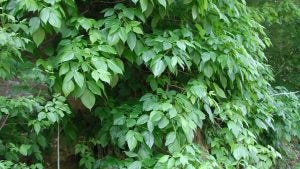Leaves of three, let it be
Published 12:07 am Saturday, May 5, 2018
I learned how to identify poison ivy the hard way. As a teenager, working at Noxubee Wildlife Refuge I had ample opportunity to encounter poison ivy. Clearing and maintaining walking trails was one of my many duties and I can still remember being covered from head to toe with the awful rash.
Poison ivy is a tall, climbing vine that is leafless in winter. As it climbs tree trunks, wooden fences or other flat structures, the stem produces many small, clinging roots. This is a good identifiable characteristic of the vine in case you can’t easily see leaves.
Poison ivy has a compound leaf consisting of three leaflets. A commonly used rhyme to remember is “Leaves of three, let it be”. The leaves are 2 to 4 inches long and can be dull or glossy green. The margins of the leaflets are variable, appearing irregularly toothed, lobed or smooth.
The agent in poison ivy responsible for causing dermatitis is urushiol. It is found in every part of the plant, including the leaves, stems, flower and even pollen. If poison ivy is burned, the urushiol can be present in the smoke, and contact with or breathing the smoke could be dangerous.
It is best to avoid poison ivy altogether. Just because you were not allergic as a child does not mean you are not allergic as an adult. If you do make contact with poison ivy, prompt washing with warm, soapy water may reduce the reaction. Special cleansers are available at drugstores.
There are three methods that can be effective in eradicating poison ivy from your landscape.
The first is hand pulling or digging the vines out when the soil is moist; getting out as much of the root as possible. Use disposable gloves or wash them with warm, soapy water after use.
The second is to carefully spray the foliage with systemic herbicide. This is only possible when the spray will not get on the foliage of desirable plants.
Systemic herbicides are absorbed by the foliage and enter the plant’s vascular system. The herbicides glyphosate (Roundup, Eraser, Hi-Yield Killzall and other brands) or triclopyr (Brush-B-Gon, Brush Killer) are commonly recommended for poison ivy control.
The third method is for larger, established vines growing up in trees or intertwined in the landscape. Spraying the vine foliage is not practical in these situations because of the potential to injure desirable trees or surrounding plants. Control is best achieved by the cut-vine method.
Cut off the vine a few inches from the ground with loppers and immediately treat the freshly cut stump with undiluted triclopyr (Greenlight Cut Vine and Stump Killer). The treated stump will die because the herbicide is absorbed through the fresh cut.
Don’t learn how to identify poison ivy the hard way. Watch out for this unwelcome plant and be prompt and aggressive in your efforts to control it.
Rebecca Bates is an MSU Extension-Lincoln County agent, and can be reached at 601-835-3460 or by e-mail at rebecca.bates@msstate.edu.






